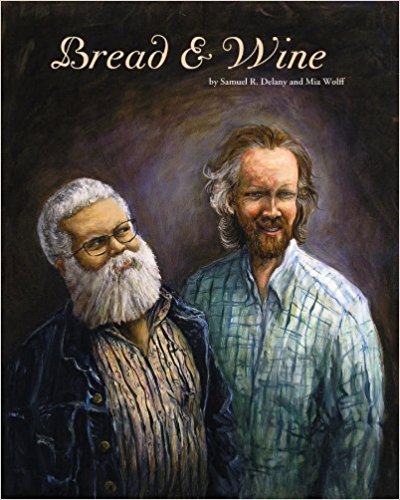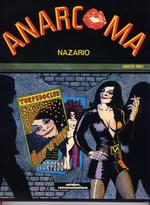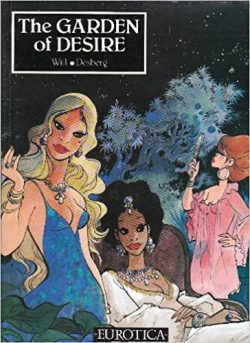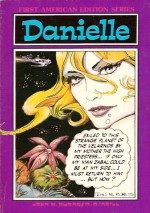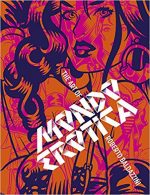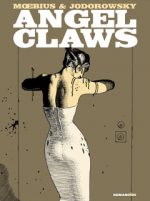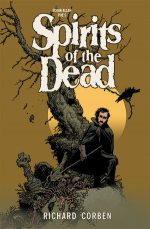
Adapted by Richard Corben, with Beth Corben Reed & Nate Piekos (Dark Horse Books)
ISBN: 978-1-61655-356-2
Richard Corben is one of America’s greatest proponents of graphic narrative: an animator, illustrator, publisher and cartoonist, catapulting from the tumultuous wave of independent counterculture commix of the 1960s and 1970s to become a major force in comic storytelling with his own unmistakable style and vision.
He is equally renowned for his mastery of airbrush, captivatingly excessive anatomical stylisation and delightfully wicked, darkly comedic horror, fantasy and science fiction tales. In later years he has become an elder statesman of horror and fantasy comics lending his gifts and cachet to such icons as John Constantine, Hulk, Hellboy, Punisher and Ghost Rider as well as new adaptations and renditions of literary classics by the likes of William Hope Hodgson, Lovecraft and the master of gothic terror Edgar Allan Poe.
Corben didn’t sell out; American publishing simply caught up, finally growing mature enough to accommodate him, due in no small part to his own broad and pervasive influence…
Born in Anderson, Missouri in 1940, he graduated with a Fine Arts degree in 1965 and found work as an animator. At that time, the neutered comicbooks of the Comics-Code Authority era were just starting to lose disaffected, malcontent older fans to the hippy-trippy, freewheeling, anything-goes publications of independent-minded creators across the continent who were increasingly making the kind of material Preachers and Mummy and her Lawyers wouldn’t approve of…
Creativity honed by the resplendent and explicitly mature 1950s EC Comics, Carl Barks’ perfectly crafted Duck tales and other classy early strips, a plethora of young artists like Corben responded with a variety of small-press publications – including Grim Wit, Slow Death, Skull, Fever Dreams and his own Fantagor – which featured shocking, rebellious, sexed-up, raw, brutal, psychedelically-inspired cartoons and strips blending the new wave of artists’ unconventional lifestyles with their earliest childhood influences… honestly crafting the kind of stories they would like to read.
Corben inevitably graduated to more professional – and paying – venues. As his style and skills developed he worked for Warren Publishing in Eerie, Creepy, Vampirella, Comix International and outrageous adult science fiction anthology 1984/1994. He famously coloured some strips for the revival of Will Eisner’s The Spirit.
Soon after he was producing stunning graphic escapades for a number of companies, making animated movies, painting film posters and producing record covers such as the multi-million-selling Meatloaf album Bat Out of Hell. He has never stopped creating comics but prefers personal independent projects or working with in-tune collaborators such as Bruce Jones, Jan Strnad and Harlan Ellison.
In 1975 Corben approached French fantasy phenomenon M̩tal Hurlant and quickly became a fixture of its American iteration Heavy Metal, cementing his international reputation in the process. Garnering huge support and acclaim in Europe, he has been regularly collected in luxurious albums even as he seemingly fell out of favour Рand print Рin his own country. Through it all he has never strayed far from his moss-covered roots.
This particular tome gathers a recent return to adaptations of the classic Poe canon; all-new, 21st century, often rather radical reinterpretations of the troubled author’s greatest works, as published in The Fall of the House of Usher #1-2, one-shots The Conqueror Worm, The Raven and the Red Death, The Premature Burial and Morella and the Murders in the Rue Morgue plus some short tales originally published in Dark Horse Presents #9, #16-18 and #28-29; collectively spanning the period November 2012-April 2014.
The horrific hagiography – each tale attributed with its year of publication and adapted with the colouring assistance of Beth Corben Reed and lettering expertise of Nate Piekos of Blambot® – opens following an erudite, informative and compelling Introduction ‘Masters of the Macabre: Edgar Allan Poe and Richard Corben’ by university professor, author, Poe expert and comics scholar Thomas M. Inge and the mood-setting poem ‘Spirits of the Dead (1827)’ before the artistic extravaganza unfolds with aged, one-eyed crone Maggy as host and guide to the selection which follows.
In ‘Alone (1828)’ morbid, death-haunted Solomon discusses his distressing dreams with the intoxicating but strangely unmoved Liea whilst ‘The City in the Sea (1831)’ sees a shipwrecked sea captain forced to explain his recent dramatic actions to a dank and unforgiving tribunal who have markedly different views to him on what constitutes duty, business sense, cargo and humanity…
Many of these interpretations employ embedded lines of Poe’s verse, such as ‘The Sleeper (1831)’ which sees a well-deserved fate meted out to a rich philanderer who had his wife and her murderer killed to further his own carnal desires whilst ‘The Assignation (1834)’ examines a toxic relationship where husband and wife cannot live together… or apart…
‘Berenice (1835)’ is one of Poe’s most stomach-churning, nerve-jangling yarns and Corben does it full justice as bereaved Egaeus watches over the corpse of his recently-deceased betrothed. However, even in death he cannot turn his mind away from an overwhelming fascination with her perfect teeth…
The deeply unsettling story of ‘Morella (1835)’ reveals how a vain witch orchestrates her own death and resurrection as her own daughter to keep her husband properly seduced and in line, before focus shifts to ancient Greece and the inevitable approach of death amongst the warriors at a funeral: a wake tainted by the unquiet dead and an oppressive ‘Shadow (1835)’…
In the luxuriously expansive ‘The Fall of the House of Usher (1839)’ artist and traveller Allan is broaches a befuddling, bilious and deadly swamp to reach the ancestral seat of the ancient Usher clan and visit an old school chum.
Like the family, the vast manse is slowly dissolving into the mire that surrounds and supports it. The decadent, failing blood of melancholic master and obsessive portraitist Roderick Usher masks many bizarre behaviours, but not even that can excuse his vile attitude to his seemingly subjugated, clandestinely closeted, sumptuously seductive deranged sister Madeline whose essence he is determined to capture on canvas at any cost…
As he stares at the too-intimate pencil studies, Allan too is drawn to the girl: a feeling only intensified once they actually meet…
By secret means she makes the visitor aware of a unique plight and urges him to assist her escape but Roderick will go to any lengths to keep his sister with him and would rather extinguish the family line rather than lose her.
That is unless the repelled, rebellious Earth doesn’t reclaim the crumbling house and the decadent Ushers first…
Infamous for his dark, doom-laden horror stories, Poe was also a pioneer of crime fiction and next up is a grimly effective and trenchantly black-humoured adaptation of the debut tale starring French gentleman detective Le Chevalier C. Auguste Dupin and his partner in peril Beluc.
Here the dandified dynamic duo put their heads together to solve an impossible locked room mystery which resulted in the brutal dismemberment of two women in ‘The Murders in the Rue Morgue (1841)’: a crime with a callous perpetrator but no culpable killer…
‘The Masque of the Red Death (1842)’ then returns to classical themes and supernal horror as plague grips the lands of regal Prospero. Faced with difficult choices, the lord opts to bring his richest cronies within his opulent castle to safely disport themselves in debauched revelry whilst the contagion burns itself out on the peasantry. Sadly, the foolish sybarite has made one grave and arrogant error which will cost him everything…
Under Corben’s imaginative purview, grim gloomy ode ‘The Conqueror Worm (1843)’ is transformed into a salutary saga of inescapable vengeance as proud Colonel Mann kills his errant wife and her lover but is tainted with a maggot that burrows into his body and soul.
Feigning innocence and ignorance, Mann salves his “tragic loss†by employing an itinerant puppet show for a family party but the mummers expose that most proper paragon’s sins before utterly consuming him, whilst in ‘The Premature Burial (1844)’ a close shave with attempted murder and molestation of the dead turns Lucian into a man obsessed with being buried alive and Arnold‘s inability to forget his dead Lenore leads to an unforgettable encounter with ‘The Raven (1845)’ in a visual tour de force every inch as potent as Poe’s poem.
Wrapping up the journey into mysteries is a deft retelling of ‘The Cask of Amontillado, (1846)’ wherein aging Montressor at last shares a long-held secret with the wife of his old friend Fortunato, now missing for many a year.
As he guides her through his deep vaults, filled with the remains of his ancestors and his precious wine collection, gloating Montressor tells the increasing nervous widow of her husband’s ghastly fate and why and how the poor, bibulous buffoon vanished so completely that long-ago night…
Accompanied by a stunning Cover Gallery, this compelling collection of classic chillers is a modern masterpiece of arcane abomination and human horror no shock addict of mystery lover will want to miss.
Spirits of the Dead™ © 2012, 2013, 2014 Richard Corben. All rights reserved.
